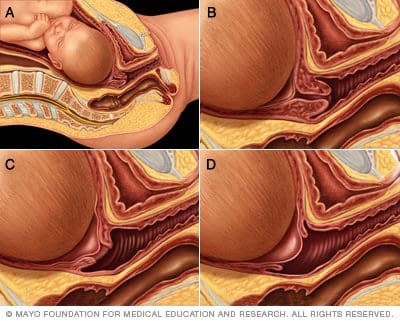Stage 1: Early labor and active labor
Cervical effacement and dilation
Cervical effacement and dilation

Cervical effacement and dilation
During the first stage of labor, the cervix opens. The medical term for this is dilation. The cervix also thins out. The medical term for this is effacement. Dilation and effacement usually happen together. This process allows the baby to move into the birth canal. In figures A and B, the cervix is tightly closed. In figure C, the cervix is 60% effaced and 1 to 2 cm dilated. In figure D, the cervix is 90% effaced and 4 to 5 cm dilated. The cervix must be 100% effaced and 10 cm dilated before a vaginal delivery.
The first stage of labor and birth happens when you begin to feel ongoing contractions. These contractions become stronger, and they happen more often as time goes on. They cause the cervix to open. This is called dilation. The contractions also soften, shorten and thin the cervix. That process is called effacement. It allows the baby to move into the birth canal.
The first stage of labor is the longest of the three stages. It's divided into two phases — early labor and active labor.
Early labor
During early labor, also called latent labor, the cervix opens and softens. It also gets shorter and thinner. The cervix opens less than 6 centimeters (cm) in early labor. Contractions tend to be mild, and they may not happen consistently.
As the cervix begins to open, you might notice a clear pink or slightly bloody discharge from your vagina. This likely is the mucus plug that blocks the cervical opening during pregnancy.
How long it lasts: Early labor isn't predictable. It may stop and start. The average length varies from hours to days. It's often shorter for people who have had a baby before.
What you can do: For many people, early labor isn't particularly uncomfortable. But contractions may be more intense for some. And sometimes contractions may continue for a long period of time during early labor. Try to stay relaxed.
The following may help keep you comfortable during early labor:
- Go for a walk.
- Take a shower or bath.
- Listen to relaxing music.
- Try breathing or relaxation techniques taught in childbirth class.
- Change positions.
If your pregnancy isn't high risk, you may spend most of your early labor at home. Most of the time, pregnant people don't need to go to a hospital or birthing center until contractions start to get more intense and happen more often. Talk to your healthcare professional about when to leave for the hospital or birthing center. If your water breaks or you have a lot of vaginal bleeding, contact your healthcare professional right away.
Active labor
During active labor, the cervix opens from 6 cm to 10 cm. Contractions become stronger and closer together. They also happen more consistently. Your legs might cramp. Your stomach may feel upset. If it didn't happen earlier, you might feel your water break. You also may feel more pressure in your back. If you haven't headed to your labor and delivery facility yet, now's the time.
Your initial excitement may fade as labor goes on and you get more uncomfortable. Ask for pain medication or anesthesia if you want it. Your healthcare team works with you to make the best choice for you and your baby. Remember, you're the only one who can judge your need for pain relief.
How long it lasts: Active labor often lasts 4 to 8 hours or more. On average, the cervix opens at approximately 1 cm an hour. But it may take longer for people who haven't had a baby before.
What you can do: Look to your labor partner and healthcare team for encouragement and support. Try breathing and relaxation techniques to ease pain. Use what you learned in childbirth class or ask your healthcare team for suggestions.
Unless you need to be in a specific position to allow for close monitoring of you and your baby, try the following to be more comfortable during active labor:
- Change positions.
- Roll on a large rubber ball (birthing ball).
- Take a warm shower or bath.
- Take a walk, stopping to breathe through contractions.
- Have a gentle massage between contractions.
If you need a Cesarean delivery, also called a C-section, having food in your stomach can lead to complications. If your healthcare professional thinks you might need a C-section, or if you have an epidural for pain relief, you may be limited to small amounts of clear liquids, such as water, ice chips, popsicles and juice, instead of solid foods.
The last part of active labor can be particularly intense and painful. Contractions come close together and can last 60 to 90 seconds. You may have pressure in your lower back and rectum. Tell a member of your healthcare team if you feel the urge to push.
If you want to push but your cervix isn't fully open, you'll likely need to wait. Pushing too soon could make you tired and cause your cervix to swell. That might delay delivery. Pant or blow through the contractions. This part of labor typically is short, lasting about 15 to 60 minutes.